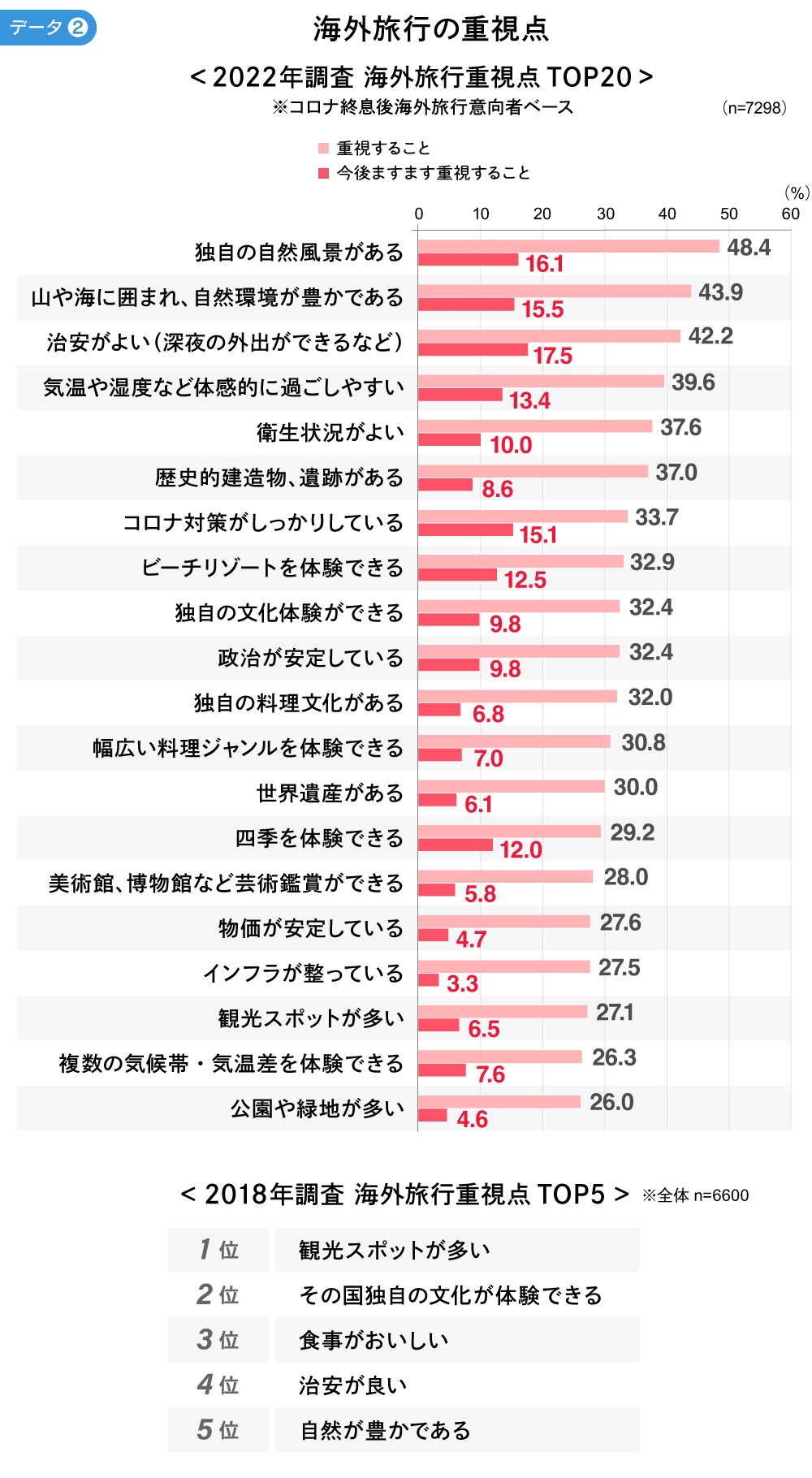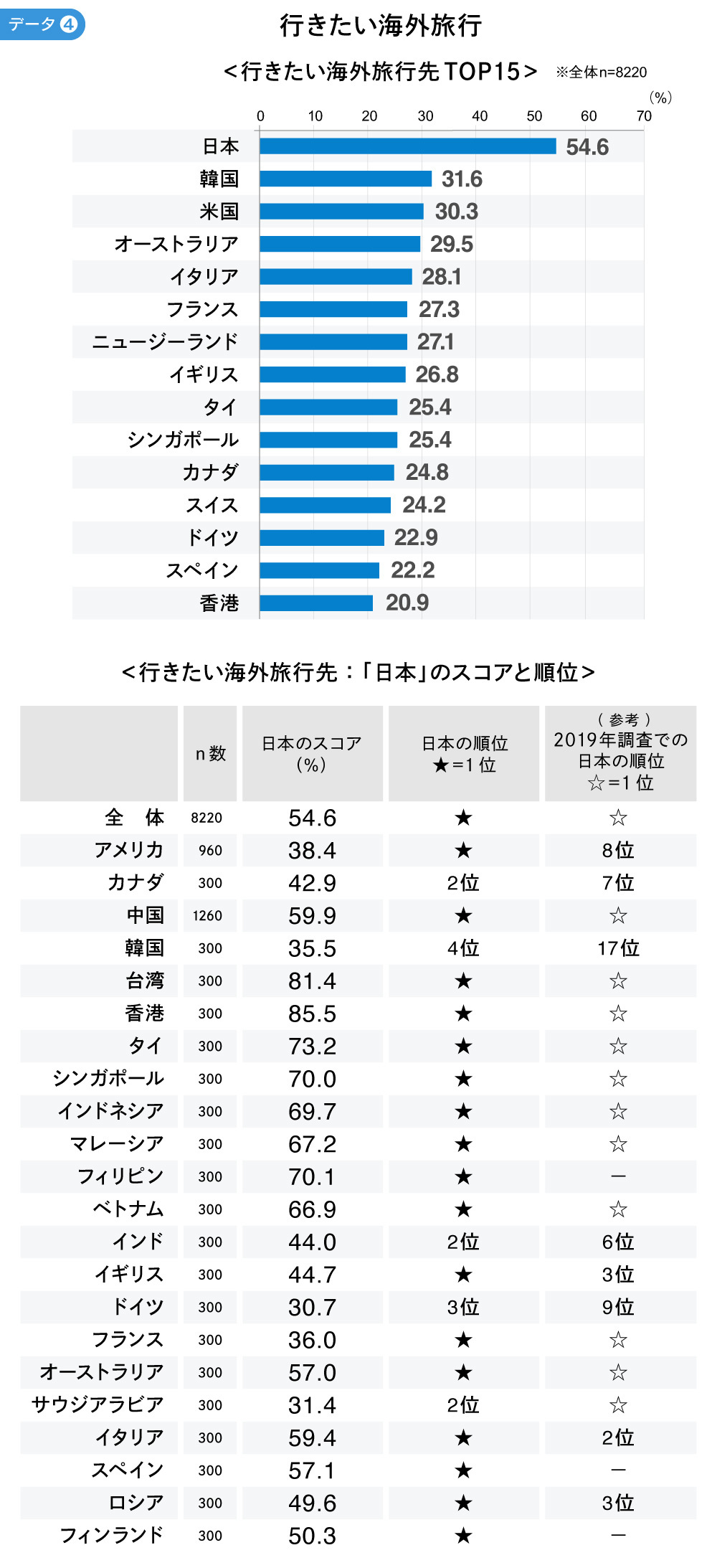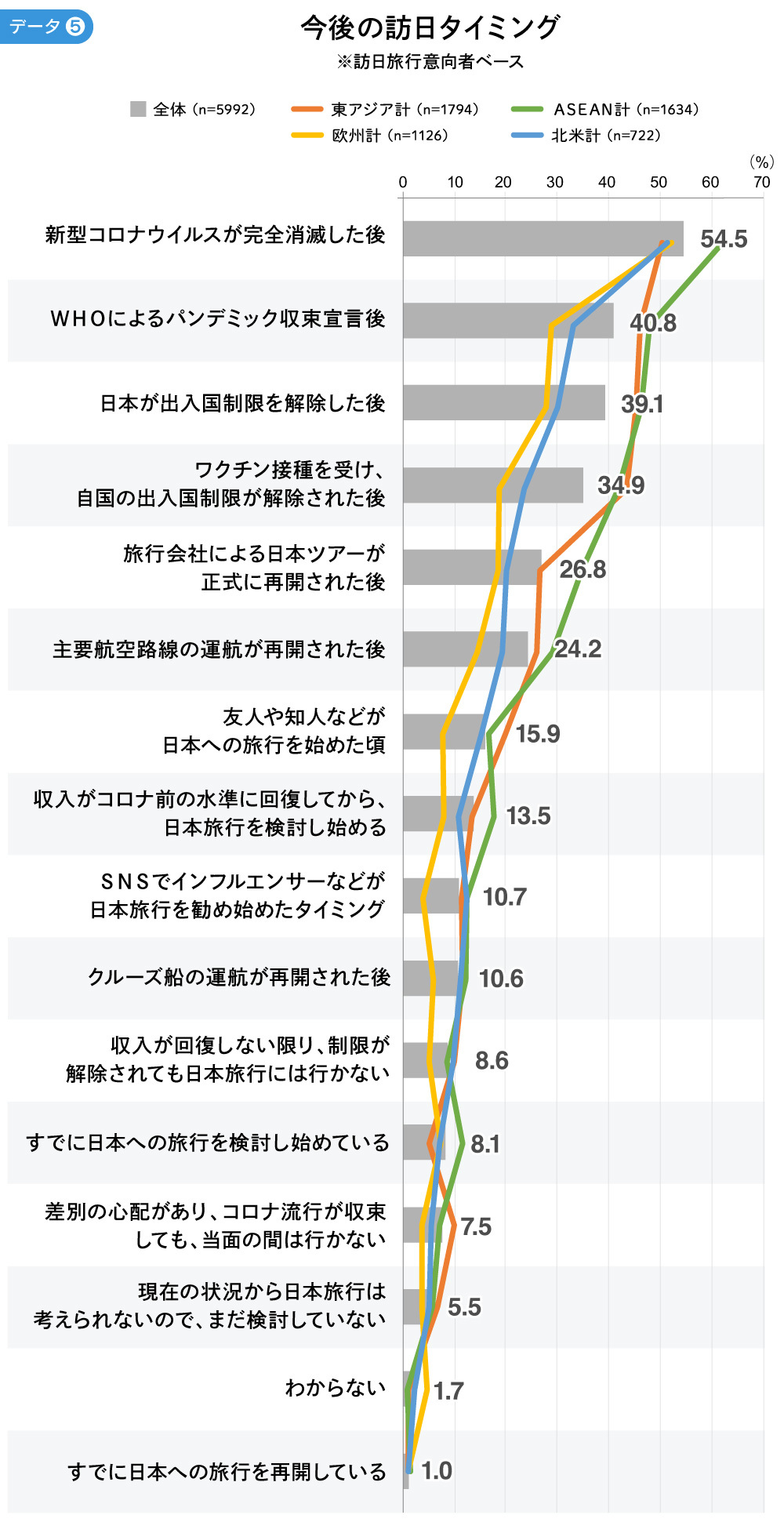The spread of the novel coronavirus temporarily imposed significant restrictions on global movement, leading to changes in lifestyles and values. While the end remains unclear, economic activity and human mobility are resuming and intensifying under the concept of "living with COVID-19."
How has the Japan brand fared after the pandemic?
What business opportunities are likely to emerge in the future?
Using the latest data from Dentsu Inc.'s Japan Brand Survey ( overview here ), a majorly revamped proprietary survey targeting high- and middle-income overseas consumers launched in 2022, we will explore the current state of the Japan brand and Japan's future potential. In Part 1 and Part 2, we will focus on the theme of "inbound tourism."
Europe is already moving, Asia is cautious. Regional differences in travel sentiment and overseas travel trends
The United Nations World Tourism Organization (UNWTO) reported that global international tourist arrivals in 2021 reached 415 million, a 4% increase from the previous year. While this remains significantly lower than the 1.461 billion recorded in 2019, the number of people already starting to travel abroad is growing.
In the 2022 Japan Brand Survey, when asked about their planned timing for overseas travel, the most common response was "after the novel coronavirus has completely disappeared." However, a significant number also stated they were "already considering countries/regions where restrictions have been lifted" or had "already resumed overseas travel."
This response was particularly common in Europe (Data ①). Separate search volume analysis using Google tools also shows that European countries saw travel-related searches recover to 2019 levels or higher earlier than others, indicating strong travel sentiment. This is likely significantly influenced by the fact that travel within the EU was permitted earlier in Europe.

*Based on those intending to travel abroad after the pandemic ends
Respondents who answered "Very likely" or "Somewhat likely" to the question "After the pandemic ends, do you plan to travel overseas? ※Limited to private tourism" were surveyed.
On the other hand, in Asia, particularly East Asian countries and regions, fewer people are considering or planning overseas travel. The score for the item "After the novel coronavirus has completely disappeared" is also significantly higher compared to Europe and America, indicating that the region is still not in an overseas travel mindset. Asia accounted for about 80% of pre-pandemic visitors to Japan and is a crucial region for Japan's inbound tourism. The timing of the recovery in travel sentiment in Asia is likely to have a major impact on Japan's future inbound tourism.
"Enjoying with peace of mind" emerges as the key phrase. How has the desire for overseas travel changed before and after COVID-19?
So, how has the demand for overseas travel changed before and after COVID? Looking at the 2022 results for "Priorities for Overseas Travel," while referencing the pre-COVID results (2018 survey) from the Japan Brand Survey, it appears that elements related to "nature" and "safety" are now being prioritized more (Data ②).

*The 2018 survey differs in target area, sample size, and response options.
In Taiwan specifically, "Good public safety" and "Good hygiene conditions" occupy the top two spots. It appears that people in Asia tend to place a very high priority on "whether they can stay with peace of mind."
Conversely, in Europe and America, nature-related items like "unique natural scenery," "surrounded by mountains and sea with rich natural environments," and "comfortable temperatures and humidity" occupy the top three spots. Travelers seem to find trips where they can breathe deeply and freely in nature appealing. This desire to "spend time in nature rather than crowded city centers" might also reflect the post-pandemic sentiment of wanting to "stay somewhere safe."
That said, travel desires haven't fundamentally changed from pre-pandemic times. In our 2022 Japan Brand Survey, when asked what would boost overseas travel motivation, the top response was "videos showcasing the destination's climate and natural appeal." This was followed closely by "videos highlighting the destination's cultural appeal" and "videos showcasing the destination's culinary appeal" (Data ③).

The universal travel desires – "wanting to experience different cultures" and "wanting to eat delicious food" – remain strong even after COVID-19. Perhaps these experiences, unavailable during the pandemic, are now sought even more intensely.
Is Japan's Inbound Tourism Okay? Expectations Grow for New Customer Segments
While we mentioned earlier that "Asians aren't in the mood for overseas travel," results show that "Japan" is a popular destination regardless of region for post-pandemic travel.
In the "Overseas Destinations You Want to Visit" survey, where respondents chose from multiple options including Japan, "Japan" was the overwhelming top choice. Moreover, Japan ranked first in 17 out of 22 countries surveyed, significantly improving its position even in countries where it hadn't ranked highly before the pandemic (Data ④).

*The 2019 survey differs in target regions, sample size, and list of options.
Before COVID, Japan was not a major travel destination for Western countries. Liberated from the stifling COVID-era lifestyle, people want to visit places they've never been to or experience a greater sense of the extraordinary. This desire, part of a rebound consumption trend, combined with Japan's natural advantages—being surrounded by sea, having distinct seasons, and maintaining a reputation for safety and cleanliness—may be driving its rising popularity as a travel destination.
So, when will tourists start returning to Japan as restrictions gradually ease? When asked about their preferred timing for future visits, "after the novel coronavirus has completely disappeared" and "after the WHO declares the pandemic over" were the top two answers. However, these seem to represent an ideal scenario (Data ⑤).

What factors actually trigger the decision to visit Japan?
Following the top two, the next highest-scoring factor is "after Japan lifts its entry/exit restrictions." With many countries and regions still maintaining restrictions, this suggests a growing trend of "going where you can go, where it's easy to go." Further deregulation in Japan appears to be a crucial timing factor.
Furthermore, in ASEAN, factors like "after travel agencies officially restart Japan tours" and "after major airline routes resume operations" highlight the importance of establishing actual means to travel.
In East Asia, where travel sentiment has been slow to recover, a tendency is also somewhat visible to wait until people actually start moving, such as "when friends or acquaintances begin traveling to Japan."
Considering these factors, it is predicted that once Japan fully eases restrictions, the first to move will likely be the high-intent travelers from Europe and America, followed by ASEAN, and finally East Asia, which will likely wait and see. Of course, this depends on the future course of the pandemic, and Asia remains a crucial target as the volume zone for inbound travelers. However, it is certain that opportunities to attract new customer segments are emerging.
This article introduced how, amid regional differences in the "with COVID" era, people are starting to move again. As overseas travel needs partially shift, Japan is gaining attention as an attractive destination. So, what should be done to actually bring foreign tourists to Japan and capitalize on this opportunity? Next time, we'll discuss hints for recovering and expanding Japan's inbound tourism.
【Contact for Inquiries Regarding This Matter】
Dentsu Inc. Japan Brand Research Project Office
japanbrand@dentsu.co.jp
【About the Dentsu Inc. Japan Brand Survey】
Dentsu Inc.'s proprietary survey launched in 2011 to understand how the Japan brand was perceived globally after reputational damage to Japanese agricultural and marine products and inbound travel following the Great East Japan Earthquake. Led by Dentsu Team Cool Japan and the Public Account Center, it underwent a major renewal in 2022 with changes to target areas and survey content.
【Dentsu Inc. Japan Brand Survey 2022 Overview】
・Target Areas: 22 countries/regions (United States, Canada, China, South Korea, Taiwan, Hong Kong, Singapore, Thailand, Malaysia, Indonesia, Vietnam, Philippines, India, Australia, Saudi Arabia, United Kingdom, France, Germany, Italy, Spain, Russia, Finland)
・Respondent Criteria: Middle-to-high income individuals, men and women aged 20s to 50s
・Sample Size: 8,220 people (United States = 960, China = 1,260, Other countries/regions = 300)
・Survey Method: Online survey
・Survey Period: December 2021 - January 2022








